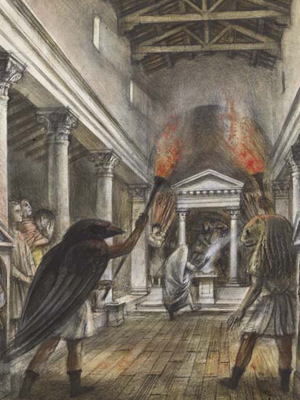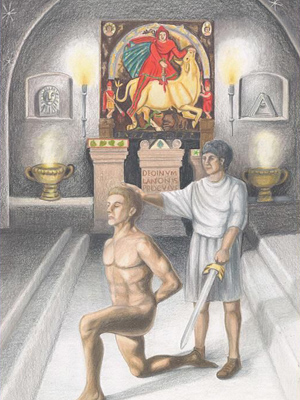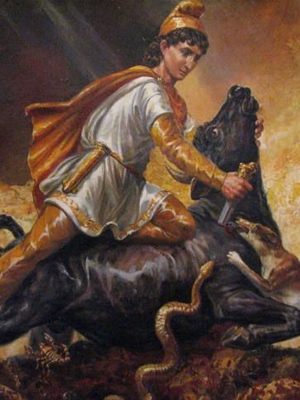Masonic Articles and Essays
Ancient Mysteries and Secret Societies Which Have Influenced Modern Masonic Symbolism - Part Three
Manly P. Hall
Date Published:
11/2/2022
The third installment of Manly P. Hall's chapter on the Ancient Mysteries investigates the connection between Freemasonry and the cryptic Roman rites of Mithras - their origin, their spread and their impact not only on Roman society but on the very fabric of Modern Masonry
 When the Persian Mysteries immigrated into Southern Europe, they were quickly assimilated by the Latin mind. The cult grew rapidly, especially among the Roman soldiery, and during the Roman wars of conquest the teachings were carried by the legionaries to nearly all parts of Europe. So powerful did the cult of Mithras become that at least one Roman Emperor was initiated into the order, which met in caverns under the city of Rome. Concerning the spread of this Mystery school through different parts of Europe, C. W. King, in his Gnostics and Their Remains, says:
When the Persian Mysteries immigrated into Southern Europe, they were quickly assimilated by the Latin mind. The cult grew rapidly, especially among the Roman soldiery, and during the Roman wars of conquest the teachings were carried by the legionaries to nearly all parts of Europe. So powerful did the cult of Mithras become that at least one Roman Emperor was initiated into the order, which met in caverns under the city of Rome. Concerning the spread of this Mystery school through different parts of Europe, C. W. King, in his Gnostics and Their Remains, says:
"Mithraic bas-reliefs cut on the faces of rocks or on stone tablets still abound in the countries formerly the western provinces of the Roman Empire; many exist in Germany, still more in France, and in this island (Britain) they have often been discovered on the line of the Picts' Wall and the noted one at Bath."
Alexander Wilder, in his Philosophy and Ethics of the Zoroasters, states that Mithras is the Zend title for the sun, and he is supposed to dwell within that shining orb. Mithras has a male and a female aspect, though not himself androgynous. As Mithras, he is the ford of the sun, powerful and radiant, and most magnificent of the Yazatas (Izads, or Genii, of the sun). As Mithra, this deity represents the feminine principle; the mundane universe is recognized as her symbol. She represents Nature as receptive and terrestrial, and as fruitful only when bathed in the glory of the solar orb. The Mithraic cult is a simplification of the more elaborate teachings of Zarathustra (Zoroaster), the Persian fire magician.
According to the Persians, there coexisted in eternity two principles. The first of these, Ahura-Mazda, or Ormuzd, was the Spirit of Good. From Ormuzd came forth a number of hierarchies of good and beautiful spirits (angels and archangels). The second of these eternally existing principles was called Ahriman. He was also a pure and beautiful spirit, but he later rebelled against Ormuzd, being jealous of his power. This did not occur, however, until after Ormuzd had created light, for previously Ahriman had not been conscious of the existence of Ormuzd. Because of his jealousy and rebellion, Ahriman became the Spirit of Evil. From himself he individualized a host of destructive creatures to injure Ormuzd.
When Ormuzd created the earth, Ahriman entered into its grosser elements. Whenever Ormuzd did a good deed, Ahriman placed the principle of evil within it. At last when Ormuzd created the human race, Ahriman became incarnate in the lower nature of man so that in each personality the Spirit of Good and the Spirit of Evil struggle for control. For 3,000 years Ormuzd ruled the celestial worlds with light and goodness. Then he created man. For another 3,000 years he ruled man with wisdom, and integrity. Then the power of Ahriman began, and the struggle for the soul of man continues through the next period of 3,000 years. During the fourth period of 3,000 years, the power of Ahriman will be destroyed. Good will return to the world again, evil and death will be vanquished, and at last the Spirit of Evil will bow humbly before the throne of Ormuzd. While Ormuzd and Ahriman are struggling for control of the human soul and for supremacy in Nature, Mithras, God of Intelligence, stands as mediator between the two. Many authors have noted the similarity between mercury and Mithras. As the chemical mercury acts as a solvent (according to alchemists), so Mithras seeks to harmonize the two celestial opposites.
There are many points of resemblance between Christianity and the cult of Mithras. One of the reasons for this probably is that the Persian mystics invaded Italy during the first century after Christ and the early history of both cults was closely interwoven. The Encyclopædia Britannica makes the following statement concerning the Mithraic and Christian Mysteries:
"The fraternal and democratic spirit of the first communities, and their humble origin; the identification of the object of adoration with light and the sun; the legends of the shepherds with their gifts and adoration, the flood, and the ark; the representation in art of the fiery chariot, the drawing of water from the rock; the use of bell and candle, holy water and the communion; the sanctification of Sunday and of the 25th of December; the insistence on moral conduct, the emphasis placed on abstinence and self-control; the doctrine of heaven and hell, of primitive revelation, of the mediation of the Logos emanating from the divine, the atoning sacrifice, the constant warfare between good and evil and the final triumph of the former, the immortality of the soul, the last judgment, the resurrection of the flesh and the fiery destruction of the universe--[these] are some of the resemblances which, whether real or only apparent, enabled Mithraism to prolong its resistance to Christianity,"
The rites of Mithras were performed in caves. Porphyry, in his Cave of the Nymphs, states that Zarathustra (Zoroaster) was the first to consecrate a cave to the worship of God, because a cavern was symbolic of the earth, or the lower world of darkness. John P. Lundy, in his Monumental Christianity, describes the cave of Mithras as follows:
"But this cave was adorned with the signs of the zodiac, Cancer and Capricorn. The summer and winter solstices were chiefly conspicuous, as the gates of souls descending into this life, or passing out of it in their ascent to the Gods; Cancer being the gate of descent, and Capricorn of ascent. These are the two avenues of the immortals passing up and down from earth to heaven, and from heaven to earth."
The so-called chair of St. Peter, in Rome, was believed to have been used in one of the pagan Mysteries, possibly that of Mithras, in whose subterranean grottoes the votaries of the Christian Mysteries met in the early days of their faith. In Anacalypsis, Godfrey Higgins writes that in 1662, while cleaning this sacred chair of Bar-Jonas, the Twelve Labors of Hercules were discovered upon it, and that later the French discovered upon the same chair the Mohammedan confession of faith, written in Arabic.
 Initiation into the rites of Mithras, like initiation into many other ancient schools of philosophy, apparently consisted of three important degrees. Preparation for these degrees consisted of self-purification, the building up of the intellectual powers, and the control of the animal nature. In the first degree the candidate was given a crown upon the point of a sword and instructed in the mysteries of Mithras' hidden power. Probably he was taught that the golden crown represented his own spiritual nature, which must be objectified and unfolded before he could truly glorify Mithras; for Mithras was his own soul, standing as mediator between Ormuzd, his spirit, and Ahriman, his animal nature. In the second degree he was given the armor of intelligence and purity and sent into the darkness of subterranean pits to fight the beasts of lust, passion, and degeneracy. In the third degree he was given a cape, upon which were drawn or woven the signs of the zodiac and other astronomical symbols. After his initiations were over, he was hailed as one who had risen from the dead, was instructed in the secret teachings of the Persian mystics, and became a full-fledged member of the order. Candidates who successfully passed the Mithraic initiations were called Lions and were marked upon their foreheads with the Egyptian cross. Mithras himself is often pictured with the head of a lion and two pairs of wings. Throughout the entire ritual were repeated references to the birth of Mithras as the Sun God, his sacrifice for man, his death that men might have eternal life, and lastly, his resurrection and the saving of all humanity by his intercession before the throne of Ormuzd. (See Heckethorn.)
Initiation into the rites of Mithras, like initiation into many other ancient schools of philosophy, apparently consisted of three important degrees. Preparation for these degrees consisted of self-purification, the building up of the intellectual powers, and the control of the animal nature. In the first degree the candidate was given a crown upon the point of a sword and instructed in the mysteries of Mithras' hidden power. Probably he was taught that the golden crown represented his own spiritual nature, which must be objectified and unfolded before he could truly glorify Mithras; for Mithras was his own soul, standing as mediator between Ormuzd, his spirit, and Ahriman, his animal nature. In the second degree he was given the armor of intelligence and purity and sent into the darkness of subterranean pits to fight the beasts of lust, passion, and degeneracy. In the third degree he was given a cape, upon which were drawn or woven the signs of the zodiac and other astronomical symbols. After his initiations were over, he was hailed as one who had risen from the dead, was instructed in the secret teachings of the Persian mystics, and became a full-fledged member of the order. Candidates who successfully passed the Mithraic initiations were called Lions and were marked upon their foreheads with the Egyptian cross. Mithras himself is often pictured with the head of a lion and two pairs of wings. Throughout the entire ritual were repeated references to the birth of Mithras as the Sun God, his sacrifice for man, his death that men might have eternal life, and lastly, his resurrection and the saving of all humanity by his intercession before the throne of Ormuzd. (See Heckethorn.)
While the cult of Mithras did not reach the philosophic heights attained by Zarathustra, its effect upon the civilization of the Western world was far-reaching, for at one time nearly all Europe was converted to its doctrines. Rome, in her intercourse with other nations, inoculated them with her religious principles; and many later institutions have exhibited Mithraic culture. The reference to the "Lion" and the "Grip of the Lion's Paw" in the Master Mason's degree have a strong Mithraic tinge and may easily have originated from this cult. A ladder of seven rungs appears in the Mithraic initiation. Faber is of the opinion that this ladder was originally a pyramid of seven steps. It is possible that the Masonic ladder with seven rungs had its origin in this Mithraic symbol. Women were never permitted to enter the Mithraic Order, but children of the male sex were initiates long before they reached maturity. The refusal to permit women to join the Masonic Order may be based on the esoteric reason given in the secret instructions of the Mithraics. This cult is another excellent example of those secret societies whose legends are largely symbolic representations of the sun and his journey through the houses of the heavens. Mithras, rising from a stone, is merely the sun rising over the horizon, or, as the ancients supposed, out of the horizon, at the vernal equinox.
John O'Neill disputes the theory that Mithras was intended as a solar deity. In The Night of the Gods he writes:
"The Avestan Mithra, the yazata of light, has '10,000 eyes, high, with full knowledge (perethuvaedayana), strong, sleepless and ever awake (jaghaurvaunghem).'The supreme god Ahura Mazda also has one Eye, or else it is said that 'with his eyes, the sun, moon and stars, he sees everything.' The theory that Mithra was originally a title of the supreme heavens-god--putting the sun out of court--is the only one that answers all requirements. It will be evident that here we have origins in abundance for the Freemason's Eye and 'its nunquam dormio.'" The reader must nor confuse the Persian Mithra with the Vedic Mitra. According to Alexander Wilder, "The Mithraic rites superseded the Mysteries of Bacchus, and became the foundation of the Gnostic system, which for many centuries prevailed in Asia, Egypt, and even the remote West."
 The most famous sculpturings and reliefs of this prototokos show Mithras kneeling upon the recumbent form of a great bull, into whose throat he is driving a sword. The slaying of the bull signifies that the rays of the sun, symbolized by the sword, release at the vernal equinox the vital essences of the earth--the blood of the bull--which, pouring from the wound made by the Sun God, fertilize the seeds of living things. Dogs were held sacred to the cult of Mithras, being symbolic of sincerity and trustworthiness. The Mithraics used the serpent a an emblem of Ahriman, the Spirit of Evil, and water rats were held sacred to him. The bull is esoterically the Constellation of Taurus; the serpent, its opposite in the zodiac, Scorpio; the sun, Mithras, entering into the side of the bull, slays the celestial creature and nourishes the universe with its blood.
The most famous sculpturings and reliefs of this prototokos show Mithras kneeling upon the recumbent form of a great bull, into whose throat he is driving a sword. The slaying of the bull signifies that the rays of the sun, symbolized by the sword, release at the vernal equinox the vital essences of the earth--the blood of the bull--which, pouring from the wound made by the Sun God, fertilize the seeds of living things. Dogs were held sacred to the cult of Mithras, being symbolic of sincerity and trustworthiness. The Mithraics used the serpent a an emblem of Ahriman, the Spirit of Evil, and water rats were held sacred to him. The bull is esoterically the Constellation of Taurus; the serpent, its opposite in the zodiac, Scorpio; the sun, Mithras, entering into the side of the bull, slays the celestial creature and nourishes the universe with its blood.
More Masonic Articles
Explore articles and essays written by Freemasons about Freemasonry.
Read More
Membership
Interested in becoming a member of the worlds oldest Fraternal organization?
Read More